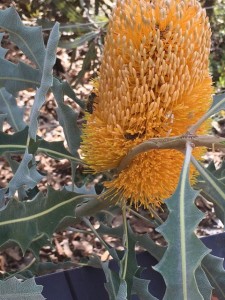
This photo, taken a few weeks ago in Perth, shows a bee foraging in a banksia. There are still opportunities for food about for the bees even this time in the season.
Folks, it’s time to start thinking about what you need to be doing as the weather is cooling down….
Until yesterday, autumn has so far given us some of the mildest weather that I can remember for this time of year. Unseasonal as it may appear to us humans, it has been a great benefit for the bees. They have worked hard and brought in much honey. This is wonderful, for it helps them to set up for what may be a cold winter when there will be many fewer days when they can leave the hive and fewer flowers to find. Bee numbers reduce in winter so they have less demand for food, but starving can still be an issue. How do we help the bees to get through this difficult season?
* Things to do
* Inspecting the hive in colder weather
* To feed or not to feed?
* Removing frames
* Moving the hive
* More resources
Things to do
* Check there is the equivalent of three or four full frames of honey. If not, feeding may be required
* As the bee numbers are lower, it is often best to reduce the number of levels so that there are no lightly occupied areas of the hive.
* Look for the presence of brood comb to be sure the hive has an active queen
* Increase the sun exposure of the hive by pruning overhanging foliage or moving the hive to a place that gets more winter sunshine.
Inspecting the hive in colder weather
We are lucky to have another warm week coming up, so inspecting the hive at the warmest part of the day is fine if we don’t take too long: doing this when it’s at least 18 degrees is best. The inspection and adjustments should be done as quickly as possible so that the hive does not cool down too much: when a hive gets too cold,
To feed or not to feed?
We look for the hive to have at least three or four fully capped frames of honey – more if possible – to provide food through winter when forage is limited. I would advise feeding the bees at this time if they have insufficient reserves. Bee Sustainable hasentrance feeders and frame feeders for sale (https://beesustainable.com.au/shop/feeder/) should you need one. Alternately, you could also feed the bees with home-made sugar syrup (two parts sugar to one part water), in a plastic bag placed on a hive mat under the lid. Remember though, it is always better if the bees have enough honey of their own stored.
Removing Frames
Typically a hive with three levels will reduce to two over winter. Take away a super with those frames that have little or no honey or are not covered by bees: you will be able to put it back in when the weather warms up.
Moving the hive
As we’ve already said, during winter it is best not to open the hive at all. If opening the hive must occur, to feed the bees for example, then it must be done in as short a time as possible and when not too cool or windy.
More resources
A fuller coverage of the issues and actions to take can be found in theNSW Department of Primary Industry notes on Wintering Bees.
And, as always, feel free to give us a call or drop in to the shop should you need any advice on managing your hive over the cooler months!
Cheers,
Rob and the team
PS Like this seasonal advice sent straight to your inbox? Sign up to our quarterly beekeeping newsletter here.

 500 Lygon Street, Brunswick East, Victoria 3057
500 Lygon Street, Brunswick East, Victoria 3057 03 9939 7301
03 9939 7301 Email Us
Email Us

